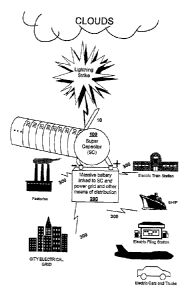Une partie des informations de ce site Web a été fournie par des sources externes. Le gouvernement du Canada n'assume aucune responsabilité concernant la précision, l'actualité ou la fiabilité des informations fournies par les sources externes. Les utilisateurs qui désirent employer cette information devraient consulter directement la source des informations. Le contenu fourni par les sources externes n'est pas assujetti aux exigences sur les langues officielles, la protection des renseignements personnels et l'accessibilité.
L'apparition de différences dans le texte et l'image des Revendications et de l'Abrégé dépend du moment auquel le document est publié. Les textes des Revendications et de l'Abrégé sont affichés :
| (12) Brevet: | (11) CA 2797815 |
|---|---|
| (54) Titre français: | SUPER CONDENSATEUR |
| (54) Titre anglais: | SUPER CAPACITOR |
| Statut: | Octroyé |
| (51) Classification internationale des brevets (CIB): |
|
|---|---|
| (72) Inventeurs : |
|
| (73) Titulaires : |
|
| (71) Demandeurs : |
|
| (74) Agent: | OSLER, HOSKIN & HARCOURT LLP |
| (74) Co-agent: | |
| (45) Délivré: | 2015-10-13 |
| (86) Date de dépôt PCT: | 2010-12-29 |
| (87) Mise à la disponibilité du public: | 2011-11-10 |
| Requête d'examen: | 2012-10-29 |
| Licence disponible: | S.O. |
| (25) Langue des documents déposés: | Anglais |
| Traité de coopération en matière de brevets (PCT): | Oui |
|---|---|
| (86) Numéro de la demande PCT: | PCT/US2010/062389 |
| (87) Numéro de publication internationale PCT: | WO2011/139315 |
| (85) Entrée nationale: | 2012-10-29 |
| (30) Données de priorité de la demande: | ||||||
|---|---|---|---|---|---|---|
|
La présente invention concerne un supercondensateur supraconducteur et un procédé de formation de condensateurs intégrés massifs reliés en parallèle sur un rayon très large qui peut varier de quelques pieds carrés à des centaines ou des milliers de miles carrés et plus. Le supercondensateur supraconducteur est formé dans un logement sous vide étanche pour éloigner l'eau et l'humidité par dépôt de plusieurs couches alternées de matériau diélectrique entre chaque couche de matériau conducteur, une ou plusieurs électrodes étant situées sur chaque couche diélectrique, formant ainsi un supercondensateur supraconducteur ayant au moins une électrode de sonde faisant saillie dudit logement et relié à la ou aux électrodes, pour recevoir une charge électrique d'une source de foudroiement, par exemple. On peut prévoir de nombreuses couches diélectriques séparant de nombreuses couches conductrices de quelques couches délinées, voire de milliers de couches délinées, et éventuellement de millions de couches délinées ou plus, par exemple, afin de définir une structure capacitive multicouche capable de fournir une énergie électrique afin de compléter ou de remplacer d'autres sources d'énergie électrique qui nuisent à l'environnement.
A super conducting super capacitor and method forming massive embedded capacitors connected in parallel over a very wide radius that can vary from a few square feet to hundreds or thousands of square miles, and more, is disclosed. The super conducting super capacitor is formed within a water proof vacuum housing to keep out water and humidity by depositing a plurality of alternating layers of dielectric material between each layer of conducting material, whereby one or more electrodes are situated on each dielectric layer, thus forming a super conducting super capacitor having at least one probe electrode exuding from said housing, and connected to the one or more electrodes, for receiving electric charge from a lightning source for example. One can contemplate many dielectric layers separating many conductor layers from a few layers to thousands, and possibly even millions or more layers delineated, for example, to define a multilayer capacitive structure capable of providing electric power to supplement or replace other sources of electric power that harm the environment.
Note : Les revendications sont présentées dans la langue officielle dans laquelle elles ont été soumises.
Note : Les descriptions sont présentées dans la langue officielle dans laquelle elles ont été soumises.

Pour une meilleure compréhension de l'état de la demande ou brevet qui figure sur cette page, la rubrique Mise en garde , et les descriptions de Brevet , États administratifs , Taxes périodiques et Historique des paiements devraient être consultées.
| Titre | Date |
|---|---|
| Date de délivrance prévu | 2015-10-13 |
| (86) Date de dépôt PCT | 2010-12-29 |
| (87) Date de publication PCT | 2011-11-10 |
| (85) Entrée nationale | 2012-10-29 |
| Requête d'examen | 2012-10-29 |
| (45) Délivré | 2015-10-13 |
Il n'y a pas d'historique d'abandonnement
Dernier paiement au montant de 263,14 $ a été reçu le 2023-12-19
Montants des taxes pour le maintien en état à venir
| Description | Date | Montant |
|---|---|---|
| Prochain paiement si taxe générale | 2024-12-30 | 347,00 $ |
| Prochain paiement si taxe applicable aux petites entités | 2024-12-30 | 125,00 $ |
Avis : Si le paiement en totalité n'a pas été reçu au plus tard à la date indiquée, une taxe supplémentaire peut être imposée, soit une des taxes suivantes :
Les taxes sur les brevets sont ajustées au 1er janvier de chaque année. Les montants ci-dessus sont les montants actuels s'ils sont reçus au plus tard le 31 décembre de l'année en cours.
Veuillez vous référer à la page web des
taxes sur les brevets
de l'OPIC pour voir tous les montants actuels des taxes.
Les titulaires actuels et antérieures au dossier sont affichés en ordre alphabétique.
| Titulaires actuels au dossier |
|---|
| MELITO INC |
| Titulaires antérieures au dossier |
|---|
| S.O. |